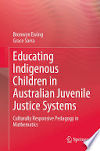- About MAA
- Membership
- MAA Publications
- Periodicals
- Blogs
- MAA Book Series
- MAA Press (an imprint of the AMS)
- MAA Notes
- MAA Reviews
- Mathematical Communication
- Information for Libraries
- Author Resources
- Advertise with MAA
- Meetings
- Competitions
- Programs
- Communities
- MAA Sections
- SIGMAA
- MAA Connect
- Students
- MAA Awards
- Awards Booklets
- Writing Awards
- Teaching Awards
- Service Awards
- Research Awards
- Lecture Awards
- Putnam Competition Individual and Team Winners
- D. E. Shaw Group AMC 8 Awards & Certificates
- Maryam Mirzakhani AMC 10 A Awards & Certificates
- Two Sigma AMC 10 B Awards & Certificates
- Jane Street AMC 12 A Awards & Certificates
- Akamai AMC 12 B Awards & Certificates
- High School Teachers
- News
You are here
Educating Indigenous Children in Australian Juvenile Justice Systems: Culturally Responsive Pedagogy in Mathematics

Publisher:
Springer
Publication Date:
2023
Number of Pages:
151
Format:
Hardcover
Price:
119.99
ISBN:
978-9811986833
Category:
Monograph
[Reviewed by , on ]
Russell Jay Hendel
11/21/2023
This book studies the general topic of educating juveniles, whether those convicted and under incarceration or those accused of crimes for which they are being dettained. The specific focus of the book is within Australia, with a special emphasis on Aboriginal and Torres Strait Islander students, with an added focus on the education of mathematics. The book is brief but adequately covers:
- Living Conditions: Both the history of persecution of these groups as well as the current conditions under which they live which contributes to the situation continuing with over-representation of these groups in prisons.
- Complex and Multiple Needs: That the living conditions as well as the incarceration leads to multiple needs intertwined in a complex manner. These can include for example issues of homelessness, poverty, school disengagement, abuse and neglect, drug and alcohol problems, and health concerns.
- Legislations: A wide variety of legislations and guidelines both from the Australian Government as well as the United Nations aimed at providing educational opportunities for those under detention.
- Attitudes and Values: That detention does not decrease crimes nor rehabilitate offenders while provision of educational opportunities has succeeded.
- Current Resources: The current instructional resources, assessment resources, textbooks, and avenues of communication for education.
- Approach for Improvement: The current approach, culturally responsive pedagogy. This approach includes enabling those detained to be proud of their cultural identity; to see their background culture as a way of life, which addresses aspirational, linguistic, familial, social, navigational, and resistant aspects of the underlying background culture. This is done to highlight the significance of privileging indigenous voices, strengthening indigenous identity, and providing positive role models both personally and professionally.
- Resilience: The resilience and incredible capacity for growth of those detained to completely turn their lives around if given a chance. The authors provide many interesting case studies.
The book is written in a non-technical narrative-friendly form. It is addressed and intended for a wide variety of groups including professionals, laypeople, scholars, elders, students, and members of government. The book has admirably accomplished its goals. I however believe that the book would have greatly benefited from a 7th chapter exploring similar rehabilitative experiments in other settings and other countries. In the space of a review I mention briefly three programs: i) The Individual Placement and Support Model (ISP) for the mentally ill adopted in several countries, ii) The Five Keys Schools and Program of California,and iii) The Vocational approach of the Israeli-based AMIT school network for socio-economically disadvantaged
children.
These programs share many attributes with the Australian program:
- They target students either in prisons or who are socio-economically or health disadvantaged
- The targets of these programs suffer from societal prejudices and the belief that only marginal improvement, not transformative improvement, can be achieved
- The integration of numerous community resources to provide a one-stop holistic program addressing multiple and complex needs,
- Provision of instructor training,
- Intense instructor-student attention, and
- Amazing success rates involving total transformation of the student’s lives.
Besides the shared attributes, I believe these programs could suggest added elements to the Australian program which would further improve it.
Russell Jay Hendel, holds a Ph.D. in theoretical mathematics and an Associateship from the Society of Actuaries. He teaches at Towson University. His interests include discrete number
theory, graph theory, applications of technology to education, problem writing, theory of pedagogy, actuarial science, and the interaction between mathematics, art, and poetry, and biblical literary exegesis.)
See the publisher's website.
- Log in to post comments




